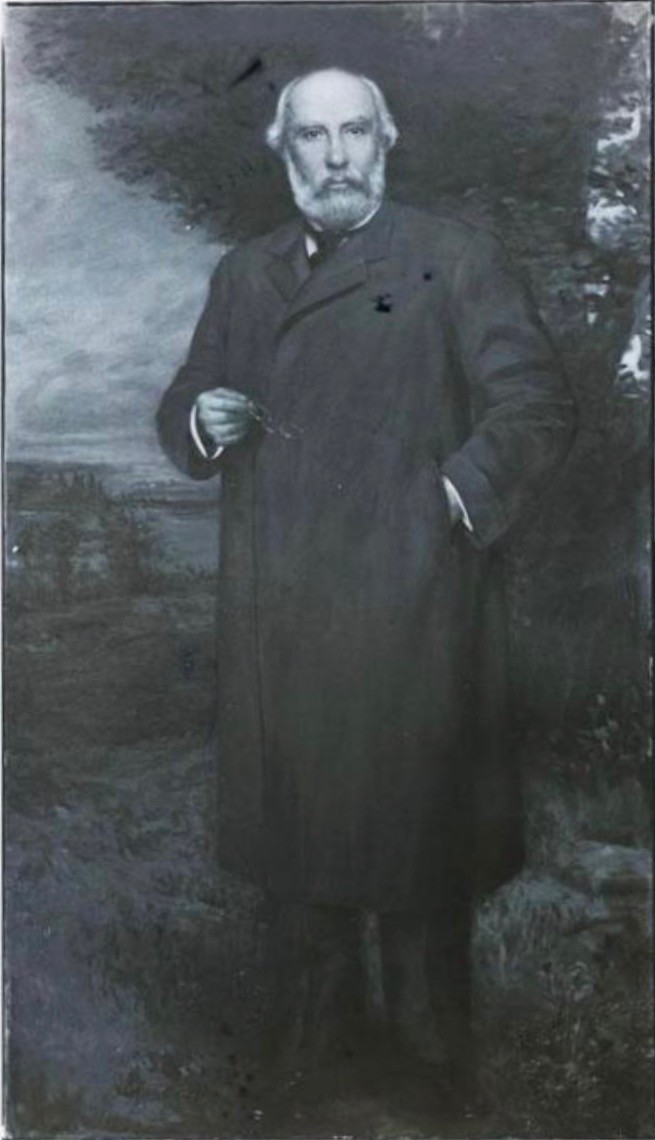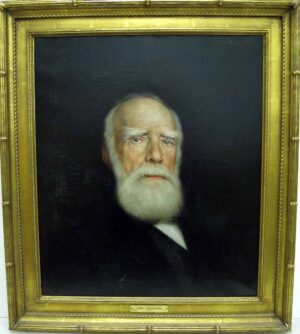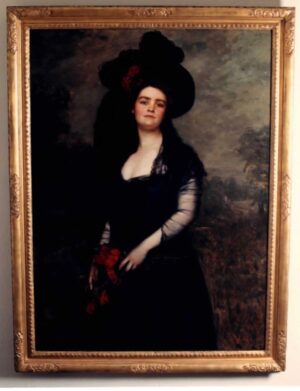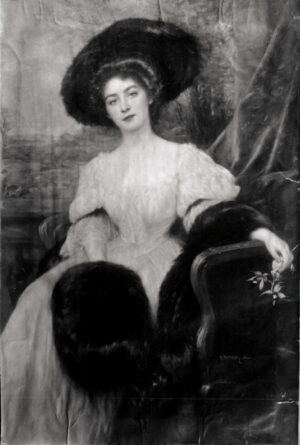The sitter was born on September 16, 1838 in Upper Canada (now Ontario). A childhood accident with a bow and arrow blinded him in the right eye. After working as a clerk in Kentucky (during which he learned bookkeeping), Hill decided to move permanently to the United States and settled in St. Paul, Minnesota, at the age of 18. His first job in St. Paul was with a steamboat company, where he worked as a bookkeeper. By 1860, he was handling freight for wholesale grocers, especially dealing with railroads and steamboats. Through this work, he learned all aspects of the freight and the transportation business. During the winter months when the Mississippi River was frozen and steamboats could not run, Hill started bidding on other transportation contracts and was often successful. By 1879 he had a monopoly (with Norman Kittson) on transportation between St. Paul and Winnipeg. At the same time he entered the coal business and again by 1879 had a local monopoly. He then entered the banking business, and he also bought out bankrupt businesses, built them up again, and resold them – often gaining a substantial profit. During the Panic of 1873 a number of railroads, including the St Paul and Pacific Railroad had gone bankrupt. For Hill it was a golden opportunity and after three years research he finally concluded that it would be possible to make a good deal of money out of this railroad, provided that the initial capital could be found. Hill teamed up with Norman Kittson (the man he had merged steamboat businesses with), Donald Smith, George Stephen and John Stewart Kennedy. Together they not only bought the railroad, they also vastly expanded it by bargaining for trackage rights with the Northern Pacific Railroad. In May 1879, the St. Paul, Minneapolis, and Manitoba Railway Co. formed – with Hill as general manager. His first goal was to expand and upgrade even more and between 1883 and 1889, Hill built his railroads across Minnesota, into Wisconsin and across North Dakota to Montana. When there was not enough industry in the areas Hill was building, Hill brought the industry in, often buying out a company and placing plants along his railroad lines. By 1889, Hill decided that his future lay in expanding into transcontinental railroad. In January 1893 his Great Northern Railway was running from St. Paul, Minnesota to Seattle, Washington — a distance of more than 1,700 miles (2,700 km). The Great Northern Railroad was the first transcontinental built without public money and few land grants and was one of the few transcontinental railroads not to go bankrupt. Careful management and economies ensured he survived the Panic of 1893, and he increased his net worth by $10 million, and began securing trade from Asian countries, and by 1901, with the aid of J. Pierpont Morgan, had gained control of the Great Pacific Railroad. He continued, against government trust opposition, to acquire more lines, became known as “The Empire Builder”, and by the time of his death in St. Paul on May 29, 1916, he was worth more than $53 million. His widow received over 16 million, and each of his children received almost 4 million. He published a book ‘Highways of Progress’ in 1910.
In 1867, James J. Hill married Mary Theresa Mehegan (born 1846) in New York City. They had ten children:
Mary Francis Hill Hill (1869–1947), who married Samuel Hill of Washington D.C. and Seattle. Samuel Hill was an executive at the Great Northern Railway when he married Mary Hill.
James Norman Hill (1870–1932) of New York.
Louis Warren Hill (1872–1948) of St. Paul who was named president of the Great Northern in 1907 and board chairman in 1912.
Clara Anne Hill Lindley (1873–1947), who married E. C. Lindley of St. Paul who was Vice President, Counsel General, and a member of the Board of Directors of the Great Northern Railway.
Katherine Theresa Hill (1875–1876) (died in infancy)
Charlotte Elizabeth Hill Slade (1877–1923), who married George T. Slade of New York and St. Paul. George T. Slade was an executive at The Great Northern Railroad and Yale classmate of Louis W. Hill.
Ruth Hill Beard (1879–1959), who married Anson McCook Beard of New York City.
Rachel Hill Boeckmann (1881–1967), who married Egil Boeckmann of St. Paul.
Gertrude Hill Gavin (1883–1961), who married Michael Gavin of New York City.
Walter Jerome Hill (1885–1944) of St. Paul.
Bibliography:
Joseph G. Pyle, The Life of James J. Hill, 2 vols., New York, 1916-17.
Albro Martin, James J. Hill & The Opening of the Northwest, Oxford University Press, New York, 1976, reprinted paper edition, St. Paul, 1991.
—
Hill was one of Muller-Ury’s earliest American patrons and remained on close terms with him until his death. Hill commissioned or owned, it has been alleged, some 30 portraits and pictures by Muller-Ury, many of them of friends, associates, and family, but only nine are recorded with payments in the records of the Minnesota Historical Society. He commissioned a number of portraits of himself from the artist. The first mention of Muller-Ury in the Hill papers (Hill Family Collection, Minnesota Historical Society, St. Paul) occurs in a letter from J. Oehme of M. Knoedler & Co. dated April 13, 1887 where he says, ‘…The portrait by Mr. Muller has also been sent…’ but it is not known if this was a portrait of Hill himself.
At least twice the artist failed to please Hill. In the Hill Papers is also a letter dated January 27, 1890 (Microfiche Vol. R-14, p.227 [Roll 34]) where Hill wrote that he acknowledged the artist’s letter of January 22 and said that he ‘…should have been glad to have taken the portrait had it been a good one: But as you know it was not, and I fear that any further efforts in that direction will be apt to meet with the same result…’ In another letter (Hill Papers) by the artist – written from the H.O. Havemeyer residence at Newport, Rhode Island – dated August 14, 1902, he says ‘…Dont (sic) you think, that it would be better to return the portrait of yours to my New York Studio so as to make the proper changes & cut it down? I(f) you think it would be better please kindly give proper orders for it…’ We also know that in August 1900, when Muller-Ury was in staying in St Paul and traveling on Hill’s yacht Wacouta on the Great Lakes, The Adams Express Company tried to deliver a large portrait of Hill to the artist at the address of his uncle and aunt Urs and Ludwina Borer of 161 West College Avenue (James J. Hill Papers) but could not as the address was written wrongly.
Portraits of Hill were exhibited as follows:
(a.) KRAUSHAAR ART GALLERIES, 260, Fifth Avenue (between 28th & 29th Streets), New York, January 5 – 19, 1901; it was mentioned in the Post, Denver, Colorado, January 20, 1901, which indicates an image ‘in black and white’ which might refer to the etching and drypoint below rather than a drawing, or indeed a painting.
(b.) THE CORCORAN GALLERY OF ART, Washington D.C., February 4 – 19, 1908, No. 8.
(c.) McCLEES GALLERIES, 1411, Walnut Street, Philadelphia, February 1908.
(d.) DUVEEN GALLERIES, 720, Fifth Avenue, New York, to April 6 – 18, 1925, No. 6; and was mentioned in the Art News, Vol. XXIII, No. 27, April 11, 1925
(e.) WILDENSTEIN’S, 19 East 64th Street, New York, April 20 – May 4, 1937, No. 9, and was mentioned in the New York Mirror, April 21, 1937
(f.) FRENCH & CO. INC., New York, April 21 – May 3, 1947, No. 15.
A portrait signed and dated 1916 was sold, Plaza Art Galleries, 9-11, East 59th Street, New York, November 24th & 25th, 1947, Sale No. 2809, Lot 165 (Fetched $22.50 – marked copy in Frick Art Reference Library)
—
This picture was photographed by the talented amateur photographer Harriet V. S. Thorne (1843-1926), a member of the New York Camera Club, many of whose photographs were donated to the Connecticut Historical Society’s Museum and Library by The Rosalie Thorne McKenna Foundation (Acquisition: 2011.344.144).
Although the photograph in the Connecticut Historical Society and Museum is unlabelled, it is unquestionably a likeness of James J. Hill. Although no full-length portrait of Hill is known to have been painted by Muller-Ury, its presence with six other pictures by the artist photographed by Thorne between 1900 and 1905 makes it highly probable that it was painted by him. Although there are a number of photographs of works by August Franzen, Arthur von Ferraris, Louis Loeb, Henry Stanley Todd and George Chickering Munzig in the Thorne Collection, the portrait of Hill is more likely to have been Muller-Ury’s work, and in any case the picture is stylistically right for a work by Muller-Ury painted between 1900 and 1905. Could this be the “large portrait” of Hill which the Adams Express Company tried to deliver to the artist in August 1900? Although there appears to be a signature lower left, the editor has included it here in the hope that evidence will come to light that confirms the attribution.





